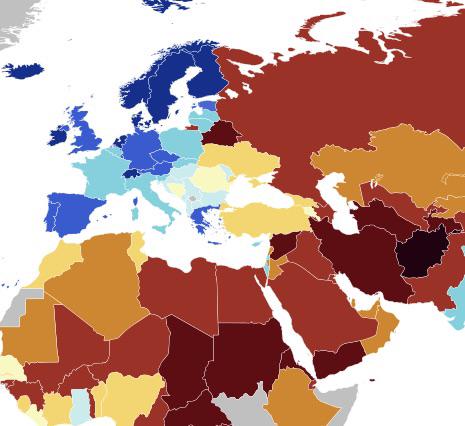Democracy Index 2024 Map of Europe


David Chen
Data Visualization Specialist
David Chen is an expert in transforming complex geographic datasets into compelling visual narratives. He combines his background in computer science ...
Geographic Analysis
What This Map Shows
The Economist’s Democracy Index 2024 map vividly illustrates the state of democracy across Europe and its neighboring regions. This index categorizes countries based on their democratic governance, civil liberties, and political culture. In this visualization, countries are color-coded to represent different levels of democracy, ranging from full democracies to authoritarian regimes. As you glance at the map, you can quickly see which nations uphold democratic values and which struggle to maintain them.
Deep Dive into Democracy Index
The Democracy Index, published annually by The Economist Intelligence Unit, is a comprehensive measure that assesses the state of democracy worldwide. It considers various factors including electoral processes, political pluralism, government functioning, political participation, and civil liberties. Interestingly, the index divides countries into four categories: full democracies, flawed democracies, hybrid regimes, and authoritarian regimes.
In Europe, the majority of countries are classified as either full or flawed democracies, showcasing a generally high standard of political freedom and civil rights. For instance, countries like Norway, Iceland, and Sweden frequently top the index as full democracies, boasting robust electoral processes and vibrant political participation. On the other hand, nations like Belarus and Russia are categorized as authoritarian, indicating significant restrictions on political rights and civil liberties.
The index reveals some intriguing trends. For example, the rise of populism and nationalism in various European countries has led to fluctuations in their democratic status. The impact of the COVID-19 pandemic also played a role in altering civil liberties across the continent, with some governments implementing strict measures that raised concerns about overreach.
What's fascinating is how the map reflects the interplay between democracy and socio-economic factors. Countries with higher GDP per capita, such as Switzerland and Germany, tend to have stronger democratic institutions. Conversely, nations facing economic instability often grapple with political unrest, which can threaten their democratic frameworks. This relationship indicates that economic well-being and democracy are intricately linked, leading to a more stable political environment.
Regional Analysis
In examining the map, one can observe distinct patterns across various regions. Northern Europe, characterized by high levels of democracy, stands in stark contrast to Eastern Europe, where several countries are experiencing democratic backsliding. For example, Hungary and Poland, once hailed as success stories of post-communist transition, now face criticism for undermining judicial independence and media freedom, placing them closer to the hybrid regime category.
Scandinavia consistently ranks as a bastion of democracy, with countries like Denmark and Finland scoring exceptionally high. These nations not only uphold democratic principles but also prioritize social welfare, education, and public trust in institutions. On the contrary, regions like the Balkans display a mixed bag of democratic practices, where countries such as Serbia and Bosnia and Herzegovina have made progress but still face challenges like corruption and political instability.
Interestingly, the South Caucasus region presents a unique case. Countries like Georgia have made strides toward democratic governance, particularly following the Rose Revolution, while Azerbaijan remains classified as an authoritarian regime, showcasing the variability in political systems within close geographical proximity.
Significance and Impact
Understanding the implications of the Democracy Index is crucial, especially as global political dynamics shift. The state of democracy in Europe not only affects its internal stability but also has broader implications for international relations and security. As democratic values face challenges from rising authoritarianism, it becomes increasingly vital for nations to foster political engagement and protect civil liberties.
Moreover, the index serves as a barometer for assessing global trends. The ongoing struggle for democracy in various parts of the world is a reminder that the fight for political freedom is far from over. As we move forward, monitoring these shifts in democracy will be essential, not only for scholars and policymakers but also for citizens who wish to advocate for their rights.
In conclusion, the Economist’s Democracy Index 2024 map serves as a powerful tool for visualizing the state of democracy in Europe and its neighboring regions. As we reflect on the various factors contributing to these rankings, one might ask: How can nations work together to strengthen democratic institutions and promote a more stable political landscape? The future of democracy in Europe, as reflected on this map, certainly warrants our attention and action.
Visualization Details
- Published
- August 12, 2025
- Views
- 134
Comments
Loading comments...